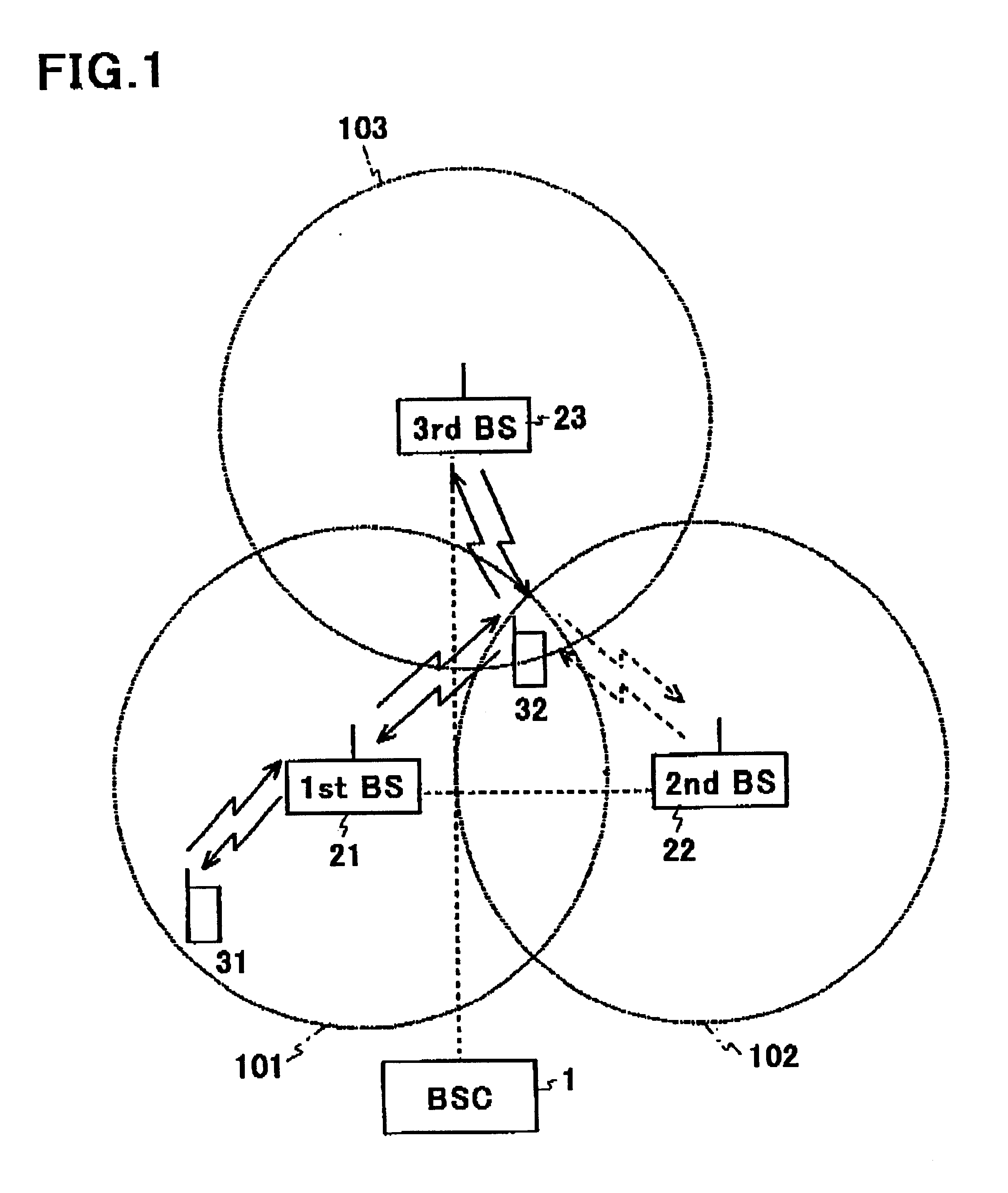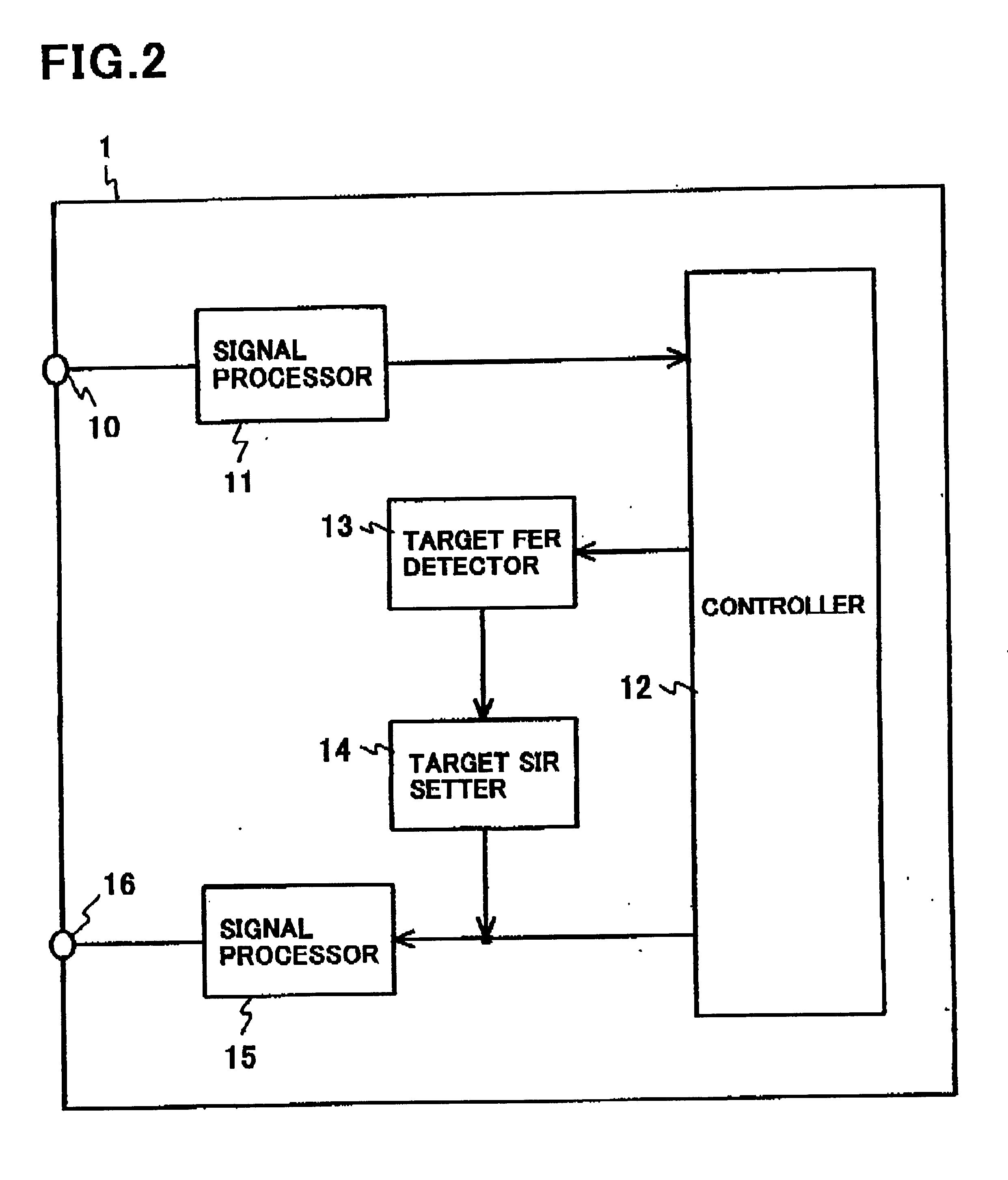Cellular system
a cellular system and system technology, applied in the field of cellular systems, can solve the problems of radio signals, radio signals are likely to be affected, and the quality of receipts is likely to be deteriorated, so as to achieve the effect of minimizing influen
- Summary
- Abstract
- Description
- Claims
- Application Information
AI Technical Summary
Benefits of technology
Problems solved by technology
Method used
Image
Examples
first embodiment
FIG. 2 is a block diagram of the base station controller 1 in accordance with the
With reference to FIG. 2, the base station controller 1 is comprised of an input terminal 10 through which signals transmitted from the first to third base stations 21 to 23 are received, a signal processor 11 which processes received signals, a controller 12 which controls signal transmission to and signal receipt from the first to third base stations 21 to 23, a target FER detector 13 which detects a target frame error rate (FER) in downward line, transmitted from a host network, a target SIR setter 14 which determines a target signal interference ratio (SIR) in upward line to the fist to third base stations 21 to 23, in accordance with the detected target FER, a signal processor 15 which processes signals to be transmitted from the base station controller 1, and an output terminal 16 through which signals are transmitted to the first to third base stations 21 to 23.
The target SIR setter 14 determines...
second embodiment
FIG. 4 is a block diagram of a base station controller 4 in accordance with the
With reference to FIG. 4, the base station controller 4 in accordance with the second embodiment is designed to have the same structure as the structure of base station controller 1 illustrated in FIG. 2 except that the base station controller 4 includes an offset power controller 41 in place of the target SIR setter 14 illustrated in FIG. 2. Parts or elements that correspond to those of the base station controller 1 illustrated in FIG. 2 have been provided with the same reference numerals, and operate in the same manner as corresponding parts or elements in the base station controller 1.
The offset power controller 41 determines offset power of an individual control signal to an individual information signal in upward line in accordance with a target FER, and transmits the thus determined offset power to the second mobile station 32 in downward line through the first and third base stations 21 and 23.
FIG....
third embodiment
FIG. 6 is a block diagram of a base station controller 5 in accordance with the
With reference to FIG. 6, the base station controller 5 in accordance with the third embodiment is designed to have the same structure as the structure of base station controller 1 illustrated in FIG. 2 except that the base station controller 5 includes a designation signal length controller 51 in place of the target SIR setter 14 illustrated in FIG. 2. Parts or elements that correspond to those of the base station controller 1 illustrated in FIG. 2 have been provided with the same reference numerals, and operate in the same manner as corresponding parts or elements in the base station controller 1.
The designation signal length controller 51 determines a signal length of a designation signal to be transmitted in upward line together with an individual control signal, in accordance with a target FER, and transmits the thus determined designation signal length to the second mobile station 32 in downward lin...
PUM
 Login to View More
Login to View More Abstract
Description
Claims
Application Information
 Login to View More
Login to View More - R&D
- Intellectual Property
- Life Sciences
- Materials
- Tech Scout
- Unparalleled Data Quality
- Higher Quality Content
- 60% Fewer Hallucinations
Browse by: Latest US Patents, China's latest patents, Technical Efficacy Thesaurus, Application Domain, Technology Topic, Popular Technical Reports.
© 2025 PatSnap. All rights reserved.Legal|Privacy policy|Modern Slavery Act Transparency Statement|Sitemap|About US| Contact US: help@patsnap.com



